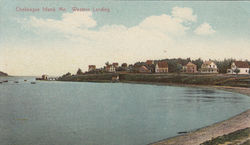Our Island Heritage
 |  |
|---|---|
 |  |
 Doughty's Landing, Chebeague |  |
 Stone Wharf, Chebeague |  |
 Hamilton Hotel Wharf, Hamilton Beach, Chebeague |  |
 Fenderson's Landing, Chebeague |  |
 Littlefield Stone Wharf, Chebeague |  |
Great Chebeague's extensive shell middens demonstrate a long, rich history of the indigenous people who were here for 4,000 years before the Europeans arrived. It is thought that their history extends back 12,000 years but sea level rise and erosion have erased most of that history. During the first half of the twentieth century, families from the Penobscot and Passamaquoddy nations spent summers on Chebeague where they sold baskets and other handmade items.
Chebeague was permanently settled by the descendants of the early Europeans who settled in New England in the 1740s. The early settlers were from the original town of North Yarmouth and many of them had deep roots in Massachusetts. Over the years islanders farmed the land and many earned livings on the sea as mariners and fishermen. The Maine Legislature allowed Cumberland to secede from North Yarmouth in 1821 after the people of Chebeague voted to join Cumberland. The outer islands have always been an important part of the Chebeague neighborhood. In the nineteenth century Bates, Ministerial, Jewell, Hope, Crow and Little Chebeague had documented year-round populations.
After the Civil War approximately 40% of the inhabitants of the Town of Cumberland lived on Chebeague and the outer islands. Chebeague had a thriving economy based on rock slooping and fishing. The mariners from Chebeague built breakwaters, wharves and lighthouses from Eastport to St. Augustine Florida, while the clam diggers provided bait to the Grand Banks fishing fleet.
Chebeague sustained its year-round community by adapting to change. During the late nineteenth and early twentieth centuries, Chebeague became a popular summer resort with as many as fourteen hotels and boarding houses operating at the same time. An out-migration of the island's youth began in the 1890s resulting in a loss of about 40% of the population by 1920. Some people moved back to the island during the Great Depression, and the population has been relatively stable ever since.
Today, Chebeague is a thriving maritime community of about 350 residents in the winter and a deeply-rooted summer population of about 1,800. More than four-dozen islanders earn their living lobstering, while equal numbers work on the island and commute to work on the mainland. Volunteerism is strong on Chebeague and over the years islanders established many non-profits and completed several ambitious building projects.
As islanders reflect on the past and look forward, they see the future of their community tied to the island school. They know that a strong, high performing school attracts and retains island families. Chebeaguers are willing to do whatever is necessary to support and sustain the island school and the future of their community. In 2005 they decided that becoming an independent town was integral to sustaining Chebeague as one of Maine’s last fifteen year-round island communities. To this end the Maine Legislature passed a bill creating the Town of Chebeague Island on April 5, 2006, and Governor John Baldacci signed the bill into law the same day. The Town of Chebeague became Maine’s newest town on July 1, 2007.
Since Chebeague became a town, the community has discovered that even a very small town has the responsibilities of much larger communities with fewer people to do the work. The community continues to move forward as it grapples with issues related to sea level rise, climate change, shifting demographics, transportation and town infrastructure, shore and open space access, and cultural changes.

